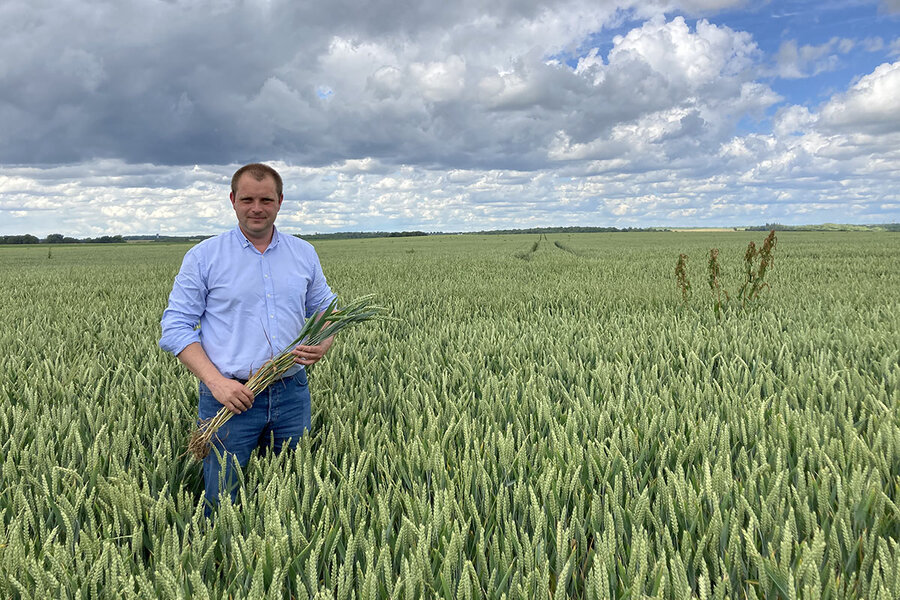Why a French heat wave could mean hunger in North Africa
Loading...
| Combs-la-Ville, France
As a new heat wave hits France this week, French farmers – in their third month of drought conditions – are feeling the heat. But while French consumers can expect to see higher prices for their beloved baguette as a result of what is expected to be reduced wheat production this season, the implications of the drought stretch farther.
North Africa and the Middle East, the largest importers of Ukrainian and Russian wheat, are also the largest consumers of the French crop. And as Russia’s invasion of Ukraine continues to block wheat exports from the Black Sea, countries in the Middle East/North Africa region must now rely heavily on European grains to meet demands.
Why We Wrote This
A story focused onNormally when France has a drought, it’s only a problem for the French. But this year, as French farmers see their yields shrink, the effects will be magnified across North Africa and the Mideast.
But as drought conditions continue, France and the rest of Europe may not be able to fill the void, leaving fragile groups at risk of supply shortages and rising food prices at a time when climate change and the pandemic have already created food insecurity.
“Even if prices go up, the French should remember that they won’t be lacking anything,” says Joël Limouzin of the French farming union FNSEA. “But on the global market, prices are becoming exorbitant and we can expect shortages. ... There will be major problems for people across the African continent.”
Guillaume Lefort combs his hands through stalks of pale green wheat, his crop stretching out behind his 19th-century farmhouse. Clouds hang ominously overhead with predictions of rain – a welcome relief from the unseasonably high temperatures that have resulted in drought conditions and troubled France’s farmers since April.
“The recent rain has helped, every little bit helps, but it’s not enough,” says Mr. Lefort, a grain farmer who owns 860 acres of land across three farms in the Combs-la-Ville area, just south of Paris. “The climate is my boss. Sometimes he’s good to us; sometimes he’s unfair. But each year it’s getting harder as the weather patterns become more erratic.”
Like wheat farmers across France and much of western Europe, Mr. Lefort is hesitant to predict the outcome of the upcoming harvest in July and August. His region has a large aquifer, so he thinks he’ll be OK this season, but in other parts of France the hot conditions have left soil too parched to replenish easily. Recent storms have done more damage than good, at times destroying wheat heads and leveling corn stalks.
Why We Wrote This
A story focused onNormally when France has a drought, it’s only a problem for the French. But this year, as French farmers see their yields shrink, the effects will be magnified across North Africa and the Mideast.
While French consumers can expect to see higher prices for their beloved baguette as a result of what is expected to be reduced wheat production this season, the implications of the drought stretch farther. North Africa and the Middle East, the largest importers of Ukrainian and Russian wheat, are also the largest consumers of the French crop. And as Russia’s invasion of Ukraine continues to block wheat exports from the Black Sea, countries in the Middle East/North Africa region must now rely heavily on European grains to meet demands.
But as drought conditions continue, France and the rest of Europe may not be able to fill the void, leaving fragile groups at risk of supply shortages and rising food prices at a time when climate change and the COVID-19 pandemic have already created food insecurity.
“Even if prices go up, the French should remember that they won’t be lacking anything. There’s no need to rush to the store and empty the shelves,” says Joël Limouzin, a livestock and grain farmer who is vice president of the French farming union FNSEA. “But on the global market, prices are becoming exorbitant and we can expect shortages. Europe will try to manage the situation, but there will be major problems for people across the African continent.”
A bad time to buy grain
The troubles for French farmers began this spring, when temperatures in parts of the country skyrocketed to 85 degrees Fahrenheit. Wheat is planted in October, and springtime is a critical period for the crop to reach its potential before the summer harvest. Excessive heat – including an expected surge of up to 100 degrees this week in France – has caused concerns about reduced output or that some grains simply won’t sprout.
Due to climate change, weather patterns have become increasingly unpredictable, with fewer weather rotations – be it cold, heat, or rain – as time goes on. Unlike their counterparts in the United States, French farmers rarely use irrigation methods, and instead rely on “crops that are historically successful and adapted to the local soil,” says Mr. Lefort. But that means they’re completely reliant on the weather for successful growth.
The French government announced at the end of April that water companies could spend an additional €100 million ($104 million) to help farmers create new reservoirs. The measure has been lauded by farmers, but it is still seen as a band-aid solution.
In the midst of the drought in France and western Europe is the Ukraine war. Ukraine is the world’s fifth largest exporter of wheat, and Russia’s blockade of Ukraine’s Black Sea ports risks heightening a global food crisis. Meanwhile, India – the world’s second largest wheat exporter – has banned all wheat exports after a succession of scorching 120 F days has caused fears that it won’t be able to feed its population.
The combined effect has caused panic on the international grains market. In Chicago, the international benchmark, wheat prices spiked to $12.68 per half bushel in mid-May, a 60% jump this year.
S&P Global estimates that Egypt, Jordan, Lebanon, Morocco, and Tunisia will be the hardest hit economically due to their high levels of food and energy imports and their reliance on grains from Ukraine and Russia. Morocco imports 33% from France, 32% from Ukraine, and 17% from Russia. Egypt, meanwhile, is the world’s largest wheat importer, getting around 85% from Russia and Ukraine.
“The Ukrainian-Russian [export supply] is so important that even without the drought, France would not be able to replace that,” says Omar Bessaoud, a professor of agricultural economics at CIHEAM-Montpellier.
Experts worry that the high prices of wheat could trigger sociopolitical instability, as they did with the bread riots in Morocco and Egypt in 1977. The Arab Spring in 2011 came at a time of steep increases in food prices.
Governments are expected to create food subsidies to cushion the blow, as Egypt has been doing for decades to help its poorest citizens. In August 2020, it reduced the size of each loaf by 20 grams (0.7 ounces) in an attempt to phase out subsidies, but it may have trouble taking more extreme measures in the current context.
“Bread is a staple food for countries like Morocco and Algeria; it’s life. The last time the government touched the price of bread, there were clashes,” says Professor Bessaoud. “If there are no negotiations with Ukraine and Russia from now until the fall, countries in North Africa are going to have huge problems to feed their populations.”
Searching for solutions
There are hopes that discussions between Russian and Turkish defense ministers last week might open up a grain export corridor, as experts warn of a global food crisis if the blockade at the Black Sea continues.
In the short term, countries that had already begun looking elsewhere for their wheat will be the most protected. A March study by the Morocco-based Policy Center for the New South found that Algeria, Morocco, and Nigeria were the most prepared to stave off the wheat crisis due to their diversification of wheat imports, some of which they learned during the COVID-19 pandemic.
Still, experts and farmers are calling for more transparency on the market to avoid an unnecessary spike in global grain prices.
“The Chicago wheat price has exploded and it’s purely based on speculation,” says Denis Perreau, national secretary of the farming union La Confédération Paysanne as well as a grain and sheep farmer. “It’s based on offer and demand, but it’s a virtual market. We don’t actually know anything until the harvest.”
In Combs-la-Ville, Mr. Lefort is focused on solutions, as the climate becomes harder to predict as years pass. He has tested out new technologies – like finding out water table levels using his cellphone – and diversified his offering. He now plants around 10 different grain varieties, including corn, beetroot for sugar, and sunflower.
“I’m an optimist by nature. I feel that it’s my role in life to feed people and find solutions,” says Mr. Lefort. “I try to take a long look to find ways to keep my farm sustainable, and become more resilient and resistant. But if we can get a big recharge of rain, that would be great.”










